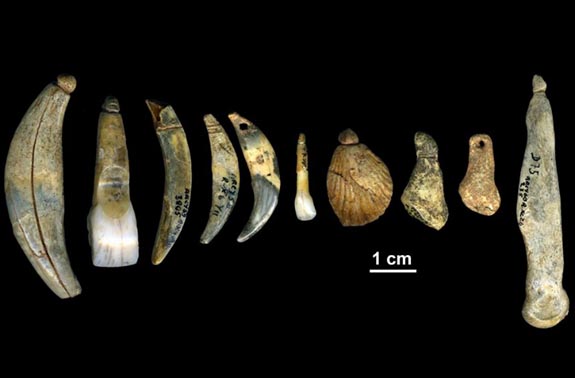Back in 1949, archaeologists discovered a trove of human-like bones and ancient jewelry in the Grotte du Renne cave in France. The artifacts dated back 40,000 years, during a time when modern humans coexisted with Neanderthals in that area.
The jewelry items were fashioned from animal teeth, shells and ivory. The elements were likely strung and worn as a necklace.

While the evidence seemed to connect the Neanderthals to the jewelry, the scientific community didn't believe Neanderthals had the capacity to express themselves symbolically. Our archaic cousins, they argued, simply didn't have the brain power to design and create items of adornment. Some scientists reasoned that the bones from the oldest layers of the excavation probably got mixed up with more recent ones by mistake.
The doubters were silenced recently when a team of European scientists, led by Matthew Collins, a bioarchaeologist at the University of York in the United Kingdom, reanalyzed the tiny bones found along with the jewelry. While they were unable to do conventional DNA testing because of the age and size of the bone samples, the team, instead, conducted a chemical analysis of the protein in the bones and compared them with known human and Neanderthal samples.

The results were conclusive. The samples were, indeed, Neanderthal.
This cutting-edge protein analysis pointed to the likelihood that the Neanderthals designed and fabricated the jewelry found in the cave. The evidence is also helping to change the way the scientific world has viewed Neanderthals. They were likely far more sophisticated and intelligent than scientists ever imagined.
Critics still hold out the possibility, however, that the Neanderthals may have simply taken the jewelry from humans or received the items as gifts from humans.
Scientists agree that Neanderthals and modern humans did interact socially during a time when humans were migrating across Europe and the Neanderthals, who had lived there for hundreds of thousands of years, were on the verge of dying out.
Credits: Jewelry by Dr. Marian Vanheren. Neanderthal man by Tim Evanson [CC BY-SA 2.0], via Wikimedia Commons.
No comments:
Post a Comment